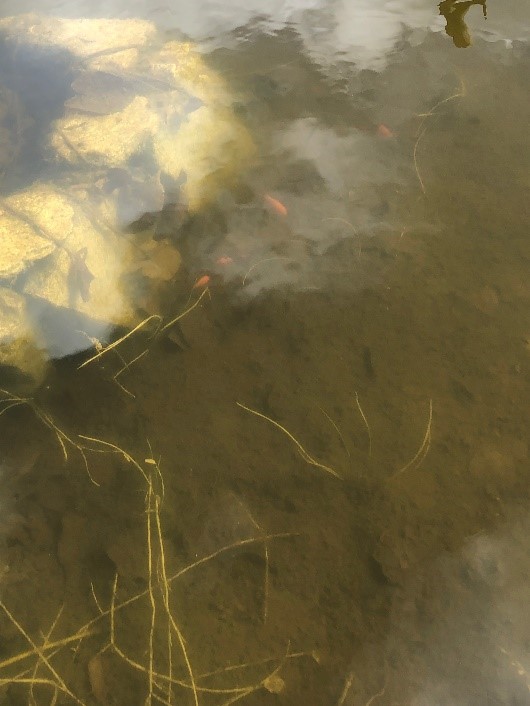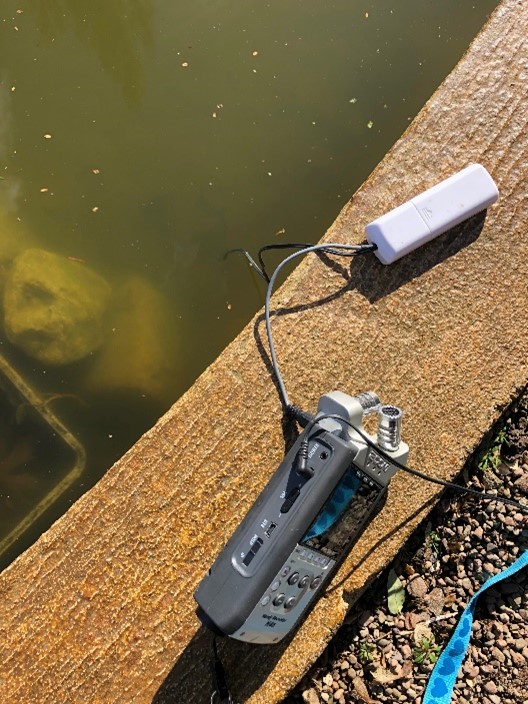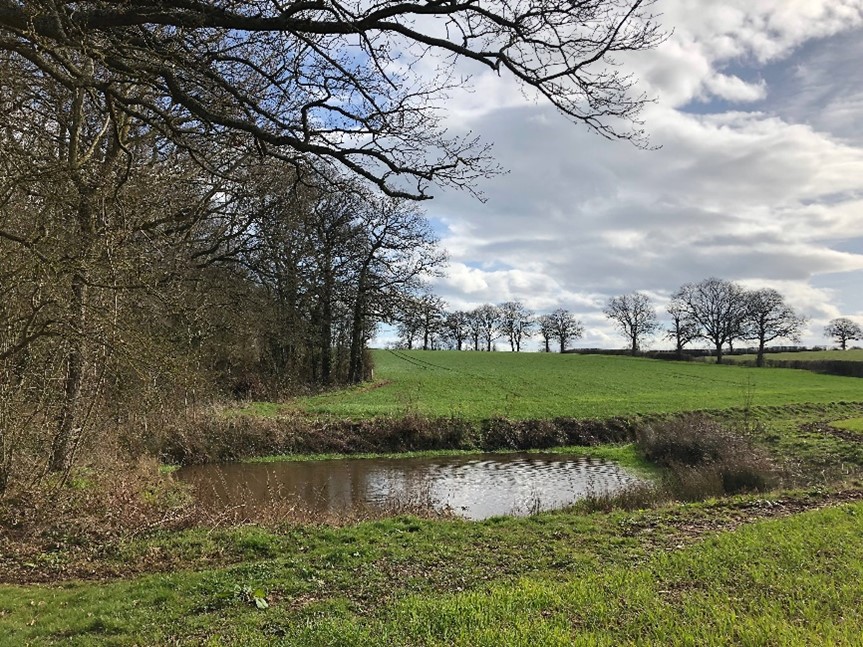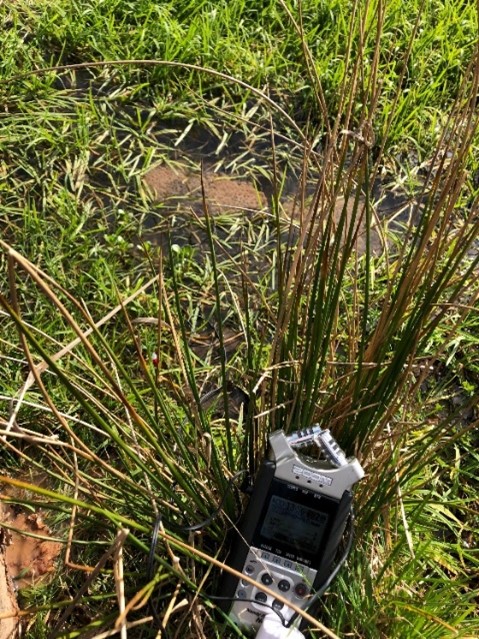This page takes the form of a series of small diary entries, taken during a stay at Hellens Manor, Much Markle, Ledbury, in March 2019; which was to obtain heritage science and conservation research. Alongside this research, observations were made of the acoustic ecology of the area, and a few recordings taken where time permitted:
“My first impression of Hellens was of its acoustic vibrancy. It was diverse and colourful with plants, animals and structures, all of which moved and animated with the impending storm that was to find its way to us. To affectively scout the landscape, would have taken up more time than was allocated to me, amongst the various experiments I would embark upon during my time there.

Through Bodies of Water – Hydrophone Experiments
Before coming to Hellens, I had been working on a new piece of equipment. This particular microphone was a hydrophone, which is a microphone made specifically for water recordings. It was created from an old pair of headphones, two tiny condenser microphones placed inside an old hollow section of metal from an aerial alongside two small nuts for weight and sealed with silicone, and a make-shift power pack made out of an old remote control. These components were all wired together and finished with a 3.5mm jack which would plug straight into my Zoom H4n hand-held recorder, allowing me the mobility to record anywhere with it.
Initially I brought this equipment to Hellens without any certainty of what kind of aquatic soundscapes I might be able to record. Part of the excitement of field recording, is the uncertainty of what your sonic environment might offer. The ephemerality of sound, and its intangible nature, means that your recordings are unique and novel, and therefore invaluable in their own standing.


Left – Goldfish in garden pond. Right – Hydrophone (connected to Zoom H4n) in garden pond.
I discovered upon arrival that there were a few ponds just outside the house with clusters of goldfish. This seemed like a good place to start testing my equipment. Unfortunately, despite researching if there are any things goldfish eat that I might be able to lure them to my microphone with, the goldfish kept very far away from the hydrophone once it was placed in the pond with them. I managed a few small recordings, and assessed the clarity of the microphone through dropping a few small pebbles in. With careful listening, there is what sounds like the movements of air bubbles under the surface, but with the fish at such a distance, I was unable to test if they could be heard.
A following outing, I wondered past the gardens and on to the fields beyond. The wind from the storm had subsided, and I was able to hear the birds clearly, conversing in antiphony with one another. This was the perfect setting for clear sound recordings. As I explored the area, I came across a small natural pond near the woodland. The sun was out as I sat by the water, and it was here that I found a huge collection of frogspawn, moving gently in the shallows. This seemed a brilliant opportunity for a second attempt at my hydrophone recording. I was able to sit quietly with the hydrophone placed carefully amongst it, and finally some faint sounds were heard, contrasting to the quiet of the goldfish pond.
Inside the Walls – Portable Recording in Hetty’s Room
Once we had begun the heritage science experiments appointed within our groups, we found ourselves spending a particularly large amount of time within a bedroom on the first floor – named Hetty’s Room. This room was the central point for all XRF readings taken to sample the window glass, and the place where members of our group most frequently crossed paths. For recordings within the house, the most compact and portable microphone set up I had was most ideal – my Zoom H4n. This allowed me to set the microphone down without the need for any cables, and work quietly, while it recorded the atmosphere.
On our first morning there, we were given a tour, and one of the most exciting stories we were told was the one surrounding the girl, Hetty, who had allegedly lived in this room during the turn of the 17th Century. She had run away with a stable-hand as a teenager, but had come home a few years later in a state of great turmoil and disarray. She was then apparently locked in her room by her parents for her own safety (or punishment) for the rest of her days, using a bell triggered through a long rope to communicate with the world outside her bedroom. Once settled in our room and beginning the preliminary XRF readings, I tested the bell for myself.
A few days later, I was required to work in Hetty’s room again, using the same XRF machine I had used previously. This was an opportunity to do a second recording in the space, and luckily there was a playful texture present – my course leader was experimenting with the harpsichord downstairs, whilst myself and a fellow course mate were conversing and jotting down readings. This faint and light-hearted accompaniment was a pleasant background to our rather repetitive work. The shaking of the wind outside was so strong; even through the old closed windows.
Ambient Bio-diversity – A Binaural Perspective on Nature


Left – View of the pond near woodland. Right – Hydrophone recording frogspawn in the pond.
I visited the fields and woodland just past Hellens on a few occassions. Firstly in the form of an early morning run with two of my course mates, and next in an attempt to carefully listen to the daffodil-patterned woods where I had been told an exciting array of bio-diversity resided. I ventured in, despite the extremely powerful wind that had gathered due to the storms across England, and was able to capture a surpisingly clear binaural microphone recording. What was particularly wonderful about this patch of woodland, was the density and height of the trees. This, combined with my fluffy windshield earmuffs, meant that inside the woods, the listener was fairly sheltered. The wind was still omnipresent and overbearing, but it hit the tops of the trees and sang through the branches, instead of interfering with the microphones so far below.
On a brighter and calmer moment, a few days later, I returned in the hope I would capture the birds I had been longing to hear. I was marginally side tracked, and I found myself at the quiet natural pond I had taken my hydrophone recording at, which was only in a neighbouring field to the woodland I had previously visited. Here birds in the trees could be heard clearly, without the shaking of their perches in the wind dominating the sonic landscape. I was able to sit silently on the muddy bank of the pond, in the warmth of the spring sun, and listen to the antiphony of birdsong. This sweet discussion was only occasionally disturbed by the smattering of local sheep bleating their own motifs from across the fields, unaware of the chorus they lent their voices to.”
